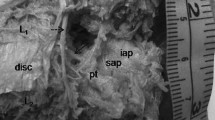Abstract
Purpose
There are only two descriptions of posterior longitudinal ligament (PLL) at the lumbar spine level but its morphologic characteristics are different to cervical and thoracic levels.
Method
Spine explantation (from Th12 to L5) followed by resection of the neural arch and the dural sheath in 13 fresh cadavers was performed. The PLL was isolated from other epidural structures and its width was measured and compared to the vertebral body width at each vertebral levels. It was conducted at a microanatomic study concerning the PLL and the posterior outer annulus fibrosus.
Results
The PLL width was reduced craniocaudaly significantly, becoming thin from L4. The average width of PLL was 7.8 mm at L1 and 1.9 mm at L5. The width decreased gradually from L1 to L5 or abruptly from L4. The ratio of PLL width compared to the vertebral body width was 21% at L1 and 3% at L5. Microanatomic study confirmed that the PLL is less thick at its annulus fibrosus adhesion at L4–L5 and L5–S1. The relationship between the PLL and other epidural structures are discussed.
Conclusions
The presence and function of the ilio-lumbar ligaments and the articular process orientation of L5–S1 may be explanations for PLL width decrease at L4–L5 and L5–S1. Furthermore, this aspect may be considered as one factor contributing to the occurrence of disc herniations at these levels, which levels are more frequently involved in this pathology.






Similar content being viewed by others
References
Abitbol MM (1987) Evolution of the lumbosacral angle. Am J Phys Anthropol 72:361–372
Abitbol MM (1987) Evolution of the sacrum in hominoïds. Am J Phys Anthropol 74:65–81
Abitbol MM (1989) Sacral curvature and supine posture. Am J Phys Anthropol 80:379–389
Barone R (1989) Anatomie comparée des mammifères domestiques. Tome 2, Arthrologie et Myologie. Vigot Frères, Paris
Behrsin JF, Briggs CA (1988) Ligaments of the lumbar spine: a review. Surg Radiol Anat 10:211–219
Harrington RM, Budorick T, Anderson PA, Tencer AF (1993) Biomechanics of indirect reduction of bone retropulsed into the spinal canal in vertebral fracture. Surg Radiol Anat 29:667–670
Hirschberg GG, Froetscher L, Naeim F (1979) Iliolumbar syndrome as a common cause of low back pain: diagnosis and prognosis. Arch Phys Med Rehabil 60:415–419
Kapandji IA (1986) Physiologie articulaire. Tome 3. Maloine, Paris
Loughenbury PR, Wadhwani S, Soames RW (2006) The posterior longitudinal and peridural (epidural) membrane. Clin Anat 19:487–492
Marty C, Commare-Nordmann MC, Deschamps H, Legaye J, Hecquet J, Duval-beaupere G (1997) Sacrum et incidence: quelles relations. Rachis 9:109–114
Manelfe C, Demandion X, Cognard C et al (2000) L’espace épidural à l’étage lombaire. Étude radio-anatomique. J Radiol 80:748–758
Okumura T, Ohhira M, Kumei S, Nozu T (2013) A higher frequency of lumbar ossification of the posterior longitudinal ligament in elderly in an outpatient clinic in Japan. Int J Gen Med 6:729–732
Ohshima H, Hirano N, Osada R, Matsui H, Tsuji H (1993) Morphologic variation of lumbar posterior longitudinal ligament and the modality of disc herniation. Spine 18:2408–2411
Paturet G (1958) Traité d’anatomie humaine, Tome III, fascicule I. Masson
Robert R, Salaud C, Hamel O, Hamel A, Philippeau JM (2009) Anatomie des douleurs de l’articulation sacro-iliaque. Revue du Rhumatisme 76:727–733
Rouvière H (1970) Anatomie humaine descriptive et topographique, tome II tronc, 10éme édition. A. Delmas, Masson
Sarkar S, Rajshekhar V (2017) Long term sustainability of functional improvement following central corpectomy for cervical spondylotic myelopathy and ossification of posterior longitudinal Ligament. Spine. https://doi.org/10.1097/BRS.0000000000002468
Tubbs RS, Loukas M, Phantana-Angkool A, Shoja M et al (2007) Posterior distraction forces of the posterior longitudinal stratified according to vertebral level. Surg Radiol Anat 29:667–670
Wadhwani S, Loughenbury P, Soames R (2004) The anterior dural (Hofmann) ligaments. Spine 29:623–627
Wiltse LL, Fonseca AS, Amster J et al (1993) Relationship of the dura, Hofmann’s ligaments, Batson’s plexus, and a fibrovascular membrane lying on the posterior surface of the vertebral bodies and attaching to the deep layer of the posterior longitudinal ligament. An anatomical, radiologic, and clinical study. Spine 18:1030–1043
Author information
Authors and Affiliations
Corresponding author
Ethics declarations
Conflict of interest
The authors declare that they have no conflict of interest.
Rights and permissions
About this article
Cite this article
Salaud, C., Ploteau, S., Hamel, O. et al. Morphometric study of the posterior longitudinal ligament at the lumbar spine. Surg Radiol Anat 40, 563–569 (2018). https://doi.org/10.1007/s00276-017-1964-2
Received:
Accepted:
Published:
Issue Date:
DOI: https://doi.org/10.1007/s00276-017-1964-2




